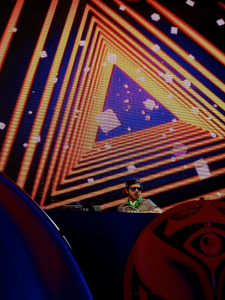By MELISSA MALLIN
CHATTAHOOCHEE HILLS, Ga. — Despite much of the negative news media attention directed towards the EDM — electronic dance music — scene, America’s new music festival TomorrowWorld, brought over from Belgium, turned out to be a huge success.
One of the biggest concerns with the festival was obviously drug use. After two deaths and many hospitalizations at Electric Zoo, a music festival held in New York, many news media outlets directed even more negative attention to the rave scene and music festivals.

Sisters Miriam and Olivia Nervo, better known as NERVO, play their set at TomorrowWorld on Sept. 28 (Photo by Melissa Mallin).
We’ve all heard about those unfortunate souls who have gone to a music festival such as Electric Zoo, EDC, and Ultra, and have overdosed and died or have been hospitalized in critical condition.
So how did TomorrowWorld, held in Chattahoochee Hills, Ga., near Atlanta, eliminate such atrocities?
To start, the festival raised its age limit to 21-plus. There were no tickets. Festival-goers received bracelets, which had to be activated in order to enter. IDs were closely checked and scanned and bags were eagerly examined. Police also walked dogs around the premises to try and sniff out illicit substances.
Precautions were taken and once fans entered the festival they disappeared into a confounded world of music and love. Investigative journalists from MSNBC bought tickets and joined the festival in an investigation to find out just how easy it was to get drugs and find “Molly.” They found many fans openly walked around offering it and many others looking to find it.
But despite the fact that, yes, drugs are very easy to come across at a music festival, the festival was one of the most successful ones ever to be produced in the United States.
Out of the 140,000 people from more than 100 countries that attended, there were absolutely no fights, few arrests and, most importantly, no deaths.
Fulton County Commissioner Robb Pitts praised the festival for being an absolute success. He cited both the economic impact and the good behavior of the attendees by stating that the festival had an “unimaginable” impact.
He also announced that Fulton County has agreed to an 8 to 10 year contract with the festival and it will most definitely be coming back.
You may be wondering why this is newsworthy?
After attending the festival myself, it pains me that the news media only follows EDM after a music festival and only reports on deaths and illicit drug use that openly takes place. What the media fails to recognize is that music festivals bring people of all cultures, from a variety of different backgrounds and different languages, together through music. Yes, there are drugs but not everyone uses them. In fact, most people go there sober, have a couple of beers and just rage.
But this is not enough to be newsworthy today. Today’s news often requires a negative element.
The news media could find meaningful and interesting feature stories by looking at the fan base and how fans prepare for such festivals. Many festival goers spend hours making Kandy (beaded bracelets) to wear and pass around to other people. When handing out bracelets they make a peace sign, a heart for love, they clasp their hands together for unity, and they pass on a bracelet out of respect. This ritual symbolizes the festival motto: PLUR — Peace, Love, Unity, Respect.
Many people also spend days trying to put together the most outrageous and sexiest of outfits. A music festival is like Halloween for three days where everybody dresses in neons, fishnets, crazy hats, short shorts, pasties, skimpy tops, fuzzy boots, body suits and so on.
It truly is a sight to be seen and could be an interesting story if the media covered the costs of buying such outfits, or simply the costs of going to the festival itself. There are so many other aspects of a music festival the media could cover besides the drug use and the negative imperfections that go on with such events.
But, again, the positive side of the music culture today does not seem to be newsworthy.
It would be nice to see media outlets recognize music festivals for what they are — a generally safe place for people to gather, socialize, dance, and ultimately experience one of the most amazing feelings in the world. It is one of the very few places where you can truly witness and experience “world peace.”
With all the hate expressed in the world today, a music festival is one of the few places where people from around the world can gather and share an experience. The love produced in these festivals is purely an epidemic that needs to be brought into the real world.
Music festivals, are honestly one of the most peaceful, happiest places you could ever have the chance to go to. It’s not all about drugs unless you make it all about drugs. For the most part, people go, dance, experience love, and it is one of the happiest places in the world, if only for a few days.
It’s the best way to escape from work and reality basically because you walk right into a new world. Your work becomes your dance and your reality becomes the stages and the beautiful installations that go with it. When the festival ends and you’re on your way home, it is indeed heartbreaking because your alter reality is over, (at least until next year) and it is time to return to the real world yet again.
For more information, visit these sites:



